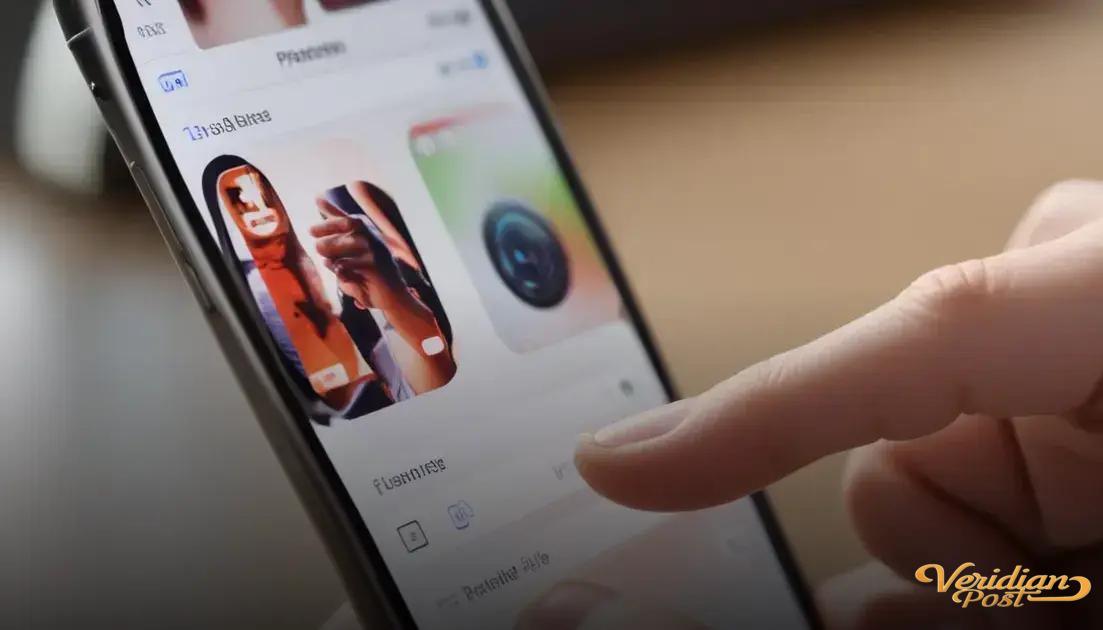How to screen record on iPhone: enable screen recording in Control Center, tap the record button to start, optionally enable microphone for external audio, then stop recording to save the video automatically to Photos for easy sharing and editing.
Wondering how to screen record on iphone? It’s simpler than you think and can save your best moments or tutorials with ease. Curious how it all works? Let’s dive in and unlock those secret steps.
how to enable screen recording on iphone
To enable screen recording on iPhone, start by opening the Settings app. Scroll down and tap on Control Center, then select Customize Controls. Here, find Screen Recording and tap the green plus icon to add it to your Control Center. This makes it easily accessible whenever you want to record your screen.
Once added, you can access the Control Center by swiping down from the top-right corner on iPhone models with Face ID or swiping up from the bottom edge on older models. You’ll see a round record button; tap it to start recording your screen. After the countdown, everything happening on your screen will be recorded.
During recording, a red bar or a red clock indicator will appear at the top of your screen to notify you that recording is active. To stop recording, either tap the red bar or open the Control Center and tap the record button again. The video will automatically save to your Photos app for easy access and sharing.
Tips for using screen recording
Make sure to turn on Do Not Disturb to avoid unwanted notifications during your recording. Also, check your storage space so the recording doesn’t stop mid-way due to lack of space. Your iPhone will record both screen and internal audio by default, but you can enable microphone audio by long-pressing the record button in Control Center and tapping the microphone icon before starting.
best settings for iphone screen recording
To get the best results when screen recording on your iPhone, adjusting a few settings can make a big difference. By default, the screen recording captures everything visible on your screen along with the internal audio. However, you can enhance your recording by customizing these options.
Choose the right audio settings
Internal audio records sounds from apps or the system itself, which is enabled automatically. To include external audio like your voice, press and hold the screen recording button in the Control Center and tap the microphone icon to turn it on. This is perfect for commentary or tutorials.
Optimize video quality and frame rate
Although iOS does not directly allow you to change the screen recording resolution or frame rate, the quality depends on your device’s screen quality and current activity. Performing recordings on newer iPhones ensures smoother videos with sharper visuals. To avoid lag, close unnecessary apps while recording.
Enable Do Not Disturb mode
Activating Do Not Disturb mode will prevent notifications from interrupting or appearing on your screen during the recording, maintaining a clean and professional video.
Manage storage space
Screen recordings can take up significant storage, especially for lengthy sessions. Check your available storage beforehand and delete unused files to ensure a smooth recording experience without interruptions.
Use guided access for focused recordings
Guided Access locks your iPhone into a single app and prevents accidental touches or switching away during recording. Activate this feature in Settings under Accessibility. This helps maintain attention on specific content.
how to record internal and external audio
Recording both internal and external audio on your iPhone screen recordings lets you capture app sounds and your voice at the same time. This is especially useful for tutorials, gameplays, or presentations where narration adds value.
Recording internal audio
By default, when you start a screen recording on an iPhone, it captures the internal audio from apps and system sounds. This means any music, notifications, or in-app sounds are recorded without additional setup.
Adding external audio (microphone)
To include your voice or other external sounds, press and hold the screen recording button in the Control Center. You’ll see the option to toggle the Microphone Audio on or off. Turn it on before starting the recording to capture external sounds.
Make sure your iPhone’s microphone is unobstructed for clear audio pick-up. You can also use external microphones for higher audio quality, connected through the Lightning port or Bluetooth.
Tips for quality recordings
Find a quiet environment to reduce background noise during recording. Before starting the final recording, test your audio levels by recording a short clip to ensure your voice is clear and balanced with the internal sounds.
Remember, mixing too many sound sources can lead to poor audio clarity, so adjust the volume levels within apps as needed.
tips to edit iphone screen recordings
Editing your iPhone screen recordings helps you create polished and focused videos. After recording, open the Photos app and select the screen recording you want to edit. Tap Edit in the top right corner to access basic editing tools.
Trim your recording
Use the trim handles on the timeline at the bottom to cut out unwanted parts from the beginning or end of the video. Drag the handles inward to select the section you want to keep, then tap Done to save the trimmed video.
Adjust video settings
You can also adjust brightness, contrast, and exposure by tapping the adjustment icon (a dial) within the editing screen. This can improve the visual quality, especially if your recording looks too dark or bright.
Add filters and effects
Choose from various filters to change the look of your video. Experimenting with filters can add mood or style, making your recording more engaging.
Use third-party apps for advanced editing
If you want to add text, annotations, or combine clips, consider using editing apps like iMovie, InShot, or Adobe Premiere Rush. These apps offer more features and control over your screen recordings.
Export and share your edits
After editing, save your video in the desired quality and share it directly from the Photos app or your editing app. Sharing options include social media, email, or cloud storage.
common issues and how to fix them
When screen recording on your iPhone, you might face some common issues that can disrupt your experience. Understanding these problems and knowing how to fix them ensures smooth recordings every time.
Screen recording button missing from Control Center
If you don’t see the screen recording option in your Control Center, it may not be added yet. Go to Settings > Control Center > Customize Controls and tap the green plus icon next to Screen Recording to add it.
Screen recording not saving to Photos
Sometimes, recordings don’t save due to lack of storage or software glitches. Check your available storage under Settings > General > iPhone Storage. If storage is low, delete unused files. Restart your iPhone to resolve temporary glitches.
Audio not recording properly
If internal or external audio isn’t being captured, ensure the microphone audio is enabled. Press and hold the screen recording button in the Control Center to toggle the microphone on or off before recording. Also, check your device’s mute switch and volume levels.
Recording stops unexpectedly
Unexpected stops can happen if there’s not enough free storage or system instability. Keep an eye on storage space and avoid running too many apps during recording. Updating your iOS to the latest version can also fix bugs causing crashes.
Quality issues in recorded videos
If your recordings appear choppy or blurry, close unnecessary apps to free up resources. Screen recordings depend on your device’s processing power, so newer iPhones typically provide better quality.
Wrapping up your iPhone screen recording experience
Screen recording on your iPhone is a powerful way to capture important moments, tutorials, or gameplays. Knowing how to enable and customize settings, record audio, and edit your videos helps you make the most out of this feature.
By being aware of common issues and simple fixes, you can avoid interruptions and create smooth, high-quality recordings every time. Practice these tips and tricks to confidently use screen recording for all your needs.
With a little effort, your iPhone screen recordings can look professional and polished, ready to share or save for later. Don’t hesitate to explore the editing tools and settings to find what works best for you.
FAQ – common questions about how to screen record on iPhone
How do I add the screen recording button to Control Center?
Go to Settings > Control Center > Customize Controls, then tap the green plus icon next to Screen Recording to add it.
Why is my screen recording not saving to Photos?
This could be due to low storage or a software glitch. Check your available storage and restart your iPhone to fix the issue.
How can I record my voice while screen recording?
Press and hold the screen recording button in Control Center, then tap the microphone icon to turn on external audio recording before starting.
What should I do if my screen recording stops unexpectedly?
Make sure you have enough free storage, close unused apps, and update your iOS to the latest version to prevent crashes.
Can I edit my screen recordings on the iPhone?
Yes, you can trim videos, adjust brightness, add filters, and use third-party apps like iMovie for more advanced editing.
How do I avoid notifications during screen recording?
Enable Do Not Disturb mode before recording to prevent notifications from appearing on your screen.

